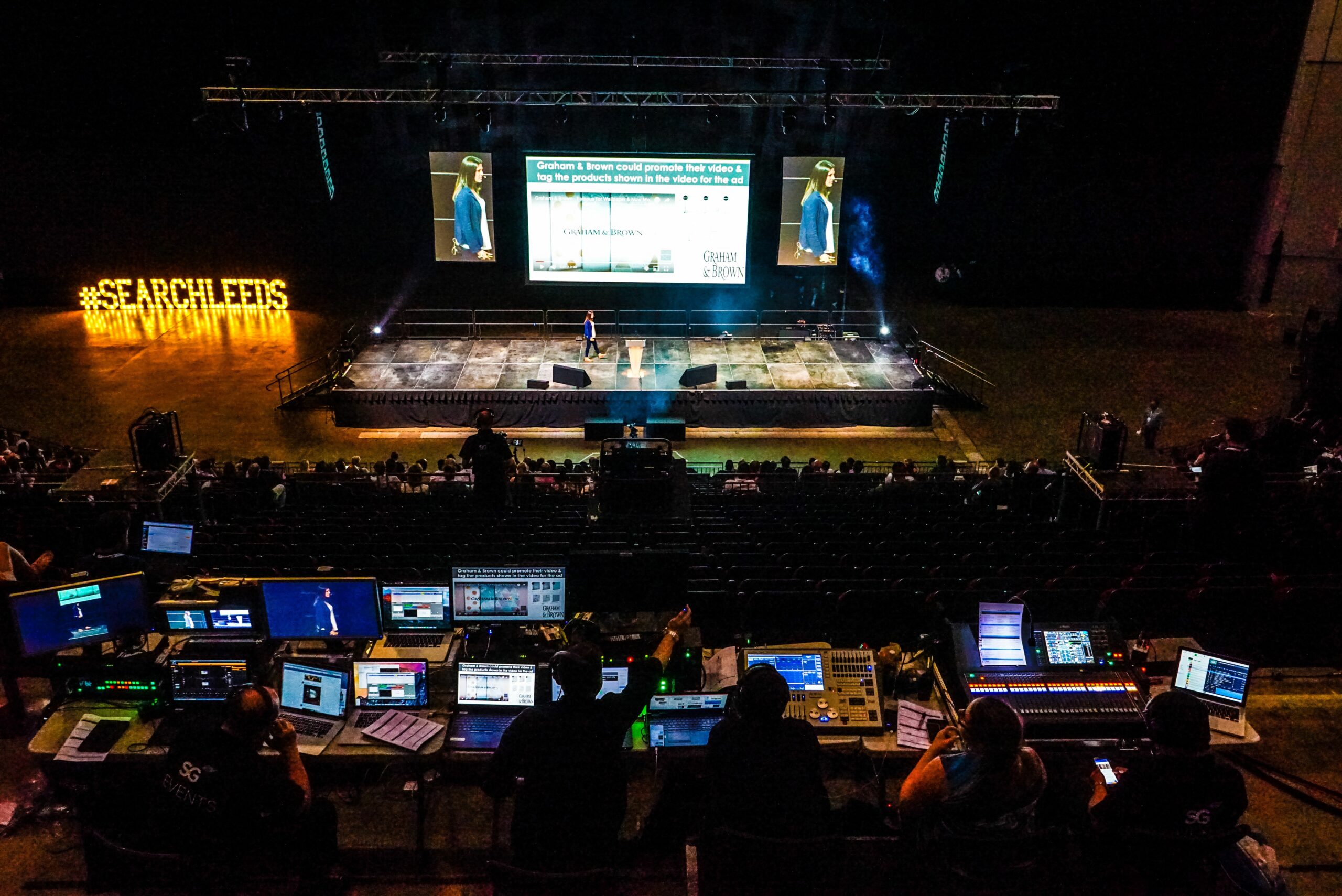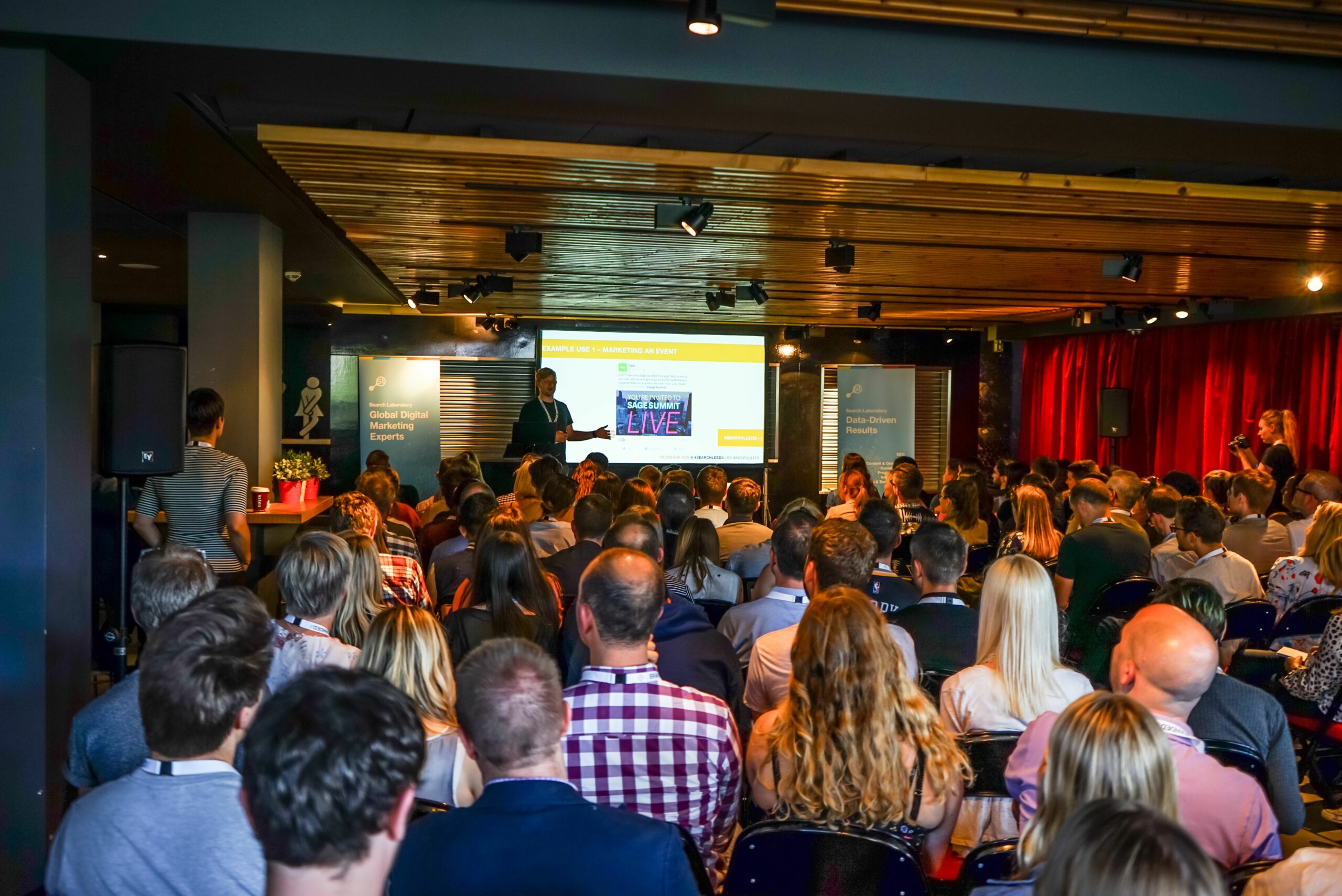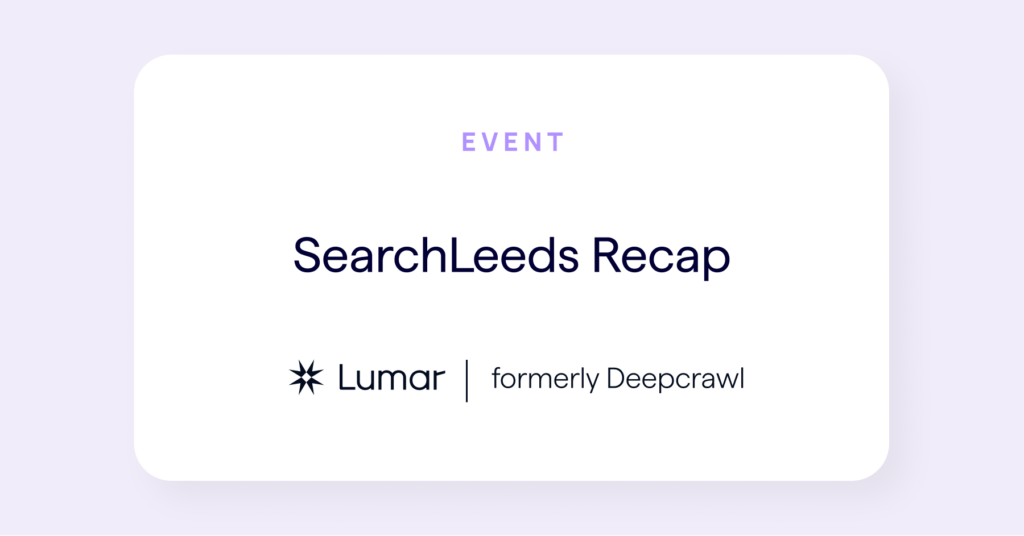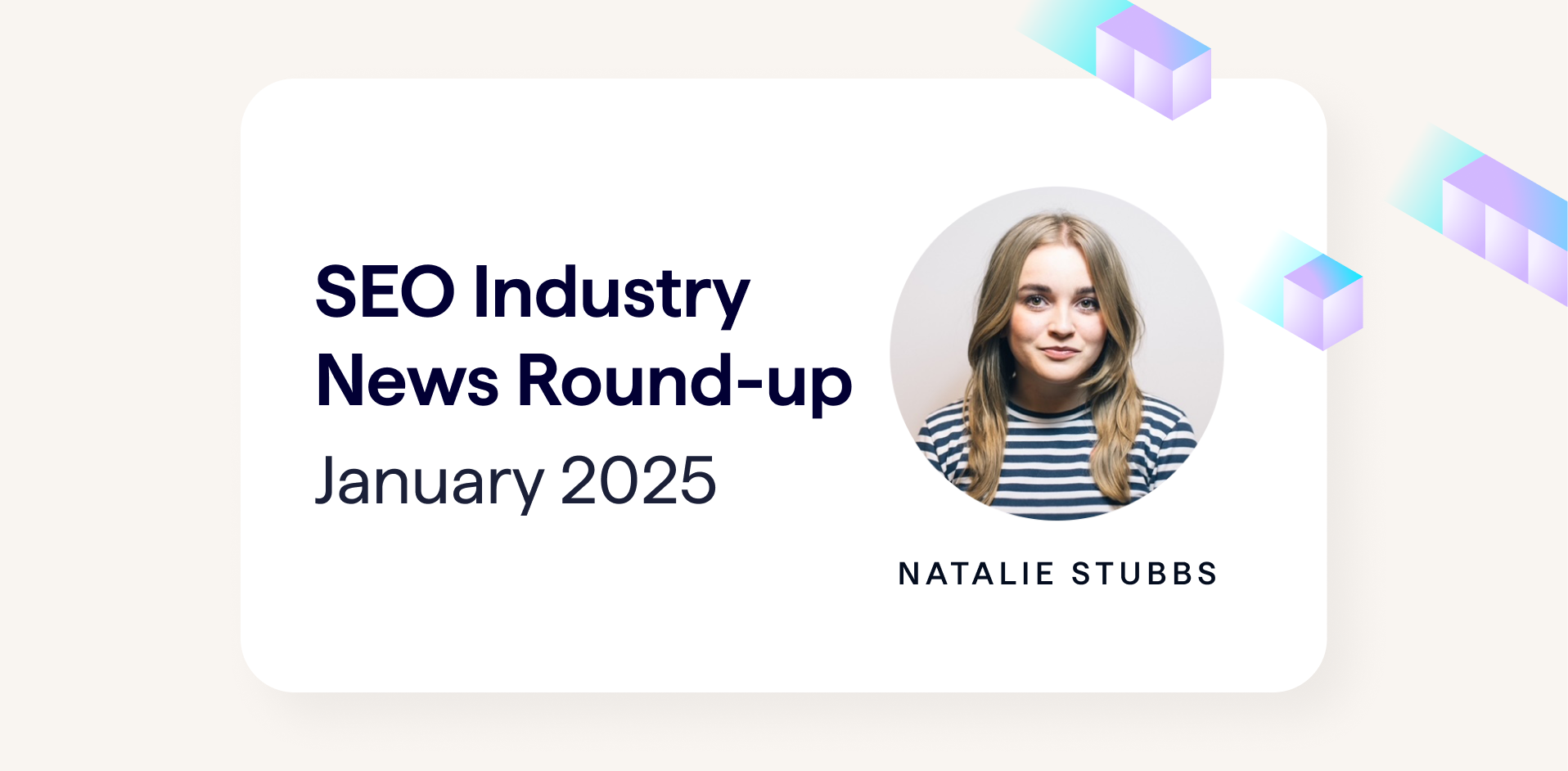
#SearchLeeds – Event Recap
Thursday the 15th of June saw the second SearchLeeds conference kick off up North. With a pre-party, after party, AND world-class speakers leading no frills talks focused on actionable data – it’s safe to say we left with our heads full of new tricks (and a slight headache!).
If you weren’t lucky enough to attend SearchLeeds or want to revisit the presentations, here’s a roundup of each of the speakers at the DeepCrawl sponsored event.
A BIG thanks to Branded3 for organising an incredibly successful event, it was a joy to be a part of it!
ditto. Amazing venue. Amazingly well organized. Fabulous networking. great speakers 🙂
— Dawn Anderson (@dawnieando) June 15, 2017
Great day at #searchleeds yesterday top sessions @DeepCrawl @stickyeyes @PoleStarDigital @PolemicDigital @Koozai #seo thanks @Branded_3 ? pic.twitter.com/mxFBfQ62bd
— Ben Wood (@digitalwoody) June 16, 2017
*Note, as this was a 3-track event we were not able to attend each of the 35 speaker sessions.

Jon Myers – Preparing your Website for Mobile-First Indexing
“In my talk, I hope people learn everything they need to consider from a mobile set up perspective. From my session I hope people can take away a lot of practical applications to apply in preparation for the switch to Mobile Index. Not only things that need to happen now – but also the future and longer term gains as we move into a different environment. Mobile is growing, and new things need to be considered to maximise the new Google order.”
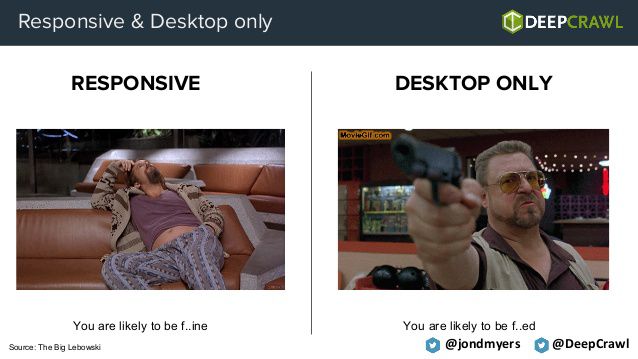
Key takeaways:
1. Pre Mobile First – History of Mobile:
- Jon walked us all the way from WAP HTML to Deep App Linking to present day Mobile First Indexing, as well as their corresponding SEO configurations:
- WAP HTML > One version for desktop devices
- Separate Mobile Pages > Dedicated mobile pages served on a separate URL e.g. m.domain or dynamically served on the same URL
- Responsive Design > One to rule them all – one version designed to work equally good on desktop and mobile
- AMP & Progressive Web Apps > Dedicated light weight version designed for a fast loading experience
- Mobile-First Indexing > Mobile becomes the primary version
“The irony is #AMP pages don’t get #indexed …they just get shown” –@JonDMyers debunking #mobile myths at #SearchLeeds
— DeepCrawl (@DeepCrawl) June 15, 2017
2. After Mobile First – The Impact Mobile-First on Different Mobile Configurations.
- There is a lot of heritage on your desktop pages, so be careful how your’e linking them!
- What are Jon’s hreflang predictions? We’re probably going to have to clean up the hreflang configuration on desktop and mobile, but Google has not confirmed concretely….
Getting ready? Here’s what you need to consider:
- Order of priority displaying in Google SERPs is 1. AMP 2. Dedicated Mobile / Dynamic 3. Responsive 4. Desktop
- Priority of indexing after Mobile-First release is 1. Dedicated Mobile / Dynamic 2. Responsive 3. Desktop 4. AMP
- Critical – Desktop only – this will be heavily affected
- High Priority – Desktop + Dedicated Mobile – this will be affected
- High Priority – Dynamic – this will be affected (e.g. content issues)
- Medium Priority – Responsive (Not affected but can still be optimised)
- Potential Issues:
- Site Architecture – Indexation, Crawlability, Canonicalisation, PageRank, Linking Structure
- -Canonicalisation note: “When Google moves to mobile first, the rel alternate and canonical tags won’t need to be changed. Rel=alternate mobile WILL take precedence over rel=canonical” -John Mueller (Webmaster Hangouts)
- Site Content: Content Differences – Think about Titles/H1s, Descriptions, Body Content. Missing Content – Responsive: hidden content (no longer an issue after mobile-first), Dynamic: missing content, Dedicated: missing content
- Tags & Markups – Schema, Hreflang configuration
- Order of Mobile-First Indexing
3. Preparing for Mobile First with DeepCrawl
- Responsive sites will be in good standing, unlike desktop only sites which will be a problem with Mobile-First
- If your website is dynamic, Jon recommends running a web crawl and an analytics/list crawl:
A) Run a crawl of your website with DeepCrawl to compare your Desktop to Mobile site structure, linking structure and crawlability – to run this crawl select user agent Googlebot B) Run a list crawl of specific URLs (to hone in on analytics data) in order to prioritise high traffic/high value pages. Both A and B will highlight if mobile configuration is setup correctly, if you don’t have any significant content differences, and if all the pages accessible on/optimised for Mobile – run this as a separate crawl with user agent Googlebot as Smartphone in order to compare and see differences across configuration/setup + content + architecture, - Generally speaking, don’t assume that just because you have a responsive site that you’ll be fine, be pragmatic and crawl your site to see its configuration
- TIP: Based on collaborative research with Majestic on the top 100k domains, DeepCrawl found that 91% of websites are NOT using the varied tag header, even though John Mueller recommended it.
- Remember, responsive design is optimal for Mobile-First!
#AMP isn’t just for news, it accepts #android pay which opens the way for #eCommerce sites that are 100% AMP-@JonDMyers #SearchLeeds
— DeepCrawl (@DeepCrawl) June 15, 2017
4. Future of the Future:
PROGRESSIVE WEB APPS!
Great day at #SearchLeeds so far. Favourite talk of the day at the moment from @JonDMyers about mobile first indexing! pic.twitter.com/zJGGpmdsdv
— Michelle (@Shelliweb) June 15, 2017
Check out Jon’s slide deck below for a step by step guide on how to crawl your dynamic, responsive or separate mobile site.
Paul Madden – Links as a metric in 2017, are they still relevant and how do we ensure value?
Key takeaways
1. Links Still Count!
- Don’t question Paul, he’s spent 15 years making a living from links and SEO
- That said how they are valued is different, it’s no longer a volume game – thanks to penalties like Penguin
2. Links Haven’t Gone Away, They’ve Just Shifted
- Links help qualify a sites trust and intent which helps makes it relevant
- Kerboo clients have seen an increase in links provide improved visibility
- Links are one of the signals, rather than dominating the signals
- Google either penalise or ignore bad links, hence factors affecting the ability of links to pass value have changed
3. Tips
- Use reavow as an SEO tactic
- It shows link are a factor that can still change ranking!
Here’s what I learned from catching up with Paul about the industry latest, and of course his talk at SearchLeeds.
What do you hope people learned from your talk?
I hope people gain a much more intimate understanding of the key issues around how links, as a signal, have changed in the last year. There are some threats and opportunities in those changes and I hope to help guide the audience through the topic and give them a number of new areas to consider and act on for their own sites.
What’s exciting you most in Search right now?
We are in a period of change. There is more change in the way search is delivered now than there has been for many years. In times like this good marketers adapt and poor marketers fail…I enjoy the chance to adapt and hopefully compete.
Check out Paul’s slide deck here:
Paul is a Co-Founder of Kerboo.
@pauldavidmadden
Matthew Court – Mobile-First Optimisation for Non-Responsive Websites
Key takeaways
1. Serve the Same Content on Desktop & Mobile Sites
- Use robots.txt testing tools to see if your mobile site is crawlable (or DeepCrawl)
2. Think with Responsive Sites Going Forward
- But remember: A good desktop site is better than a bad mobile experience
- Build up your mobile site and launch only when it’s good and truly ready
3. When Devs Make Changes on Desktop or Mobile Counter it – Suggest they do both!
- It’s not an either or situation, and we shouldn’t be having this conversation at this point!
- If your primary content is different across mobile and desktop – it shouldn’t be
- Don’t confuse Google! Make sure your mobile users are landing on the correct pages – it will increase the right stats for you, e.g. sessions + new users
- Make a great website and give users the content they need
- Don’t have a mobile site? Google will crawl your desktop version
- Like Jon Myers, Matthew also believes you shouldn’t have to change anything for the Mobile First update if you’ve got a responsive site
- REMINDER: A GOOD desktop site is better than a BAD mobile site
Check out Matthew’s slide-deck here:
Matthew is SEO/PPC Consultant at Auto Trader.
James Carson – Audience development: How SEO and social work together at a large publisher
Head of SEO and Social at the @Telegraph @mrjamescarson presenting on the main stage at #searchleeds pic.twitter.com/wlIwx8ZtTX
— Branded3 (@Branded_3) June 15, 2017
Key takeaways
1. Think About What Success Looks Like on Search versus Social
- It’s important to meet and discuss key points and define what you need across your teams
- Focus on the best way of telling a story: text based article, listical, video, gallery, infographic or a mixture? Think about what works best for the particular story YOU are telling
- Distribute evergreen content via database
- Think about what works where:
A) trending stories are a match made in heaven for social and will do better on social than they will on search
B) evergreen content does better for search than social (usually)
C) who/what/when/where pieces are much more effective on search than social, whereas big news stories do well on both - If you have a lot of new pieces coming in – create new live blogs to cope
- Remember: People focus on titles – you should too! Your headline drives engagement for people to atually read it
Your headline is 80% of your copy. @mrjamescarson #SearchLeeds pic.twitter.com/lDeLU1Oyux
— Barry Adams (@badams) June 15, 2017
2. Tool tips – James gives us the scoop on what works for SEO & Social at a large publisher like The Telegraph
- Buzzsumo for social sharing or keyword planning for analysis
- Automate your Twitter via RSS if you’re publishing at volume
- Recommendation: Check out Ogilvy’s book on Advertising
The kind of content successful on search is markedly different to that which is successful on social @mrjamescarson @Telegraph #SearchLeeds pic.twitter.com/BlI2jq1fET
— Natasha Ellard (@urban_element_) June 15, 2017
3. Social Channels are not Created Equal
- Facebook drives traffic to serendipitous stuff like Larry the Cat but not to huge news events like the conservative manifesto
- It’s important to look at onside audience data and social network data and search engine rankings reports – have a huddle with your team and discuss performance
- Don’t beat yourself up – appreciate that not everything will work on social
- The Telegraph posts everything on Twitter, whereas they only post what they believe to effective on specific other channels like Facebook in order to get really good traction
Does your headline make sense in isolation AND create intrigue? Lots of food for thought from @mrjamescarson @Telegraph at #SearchLeeds!
— DeepCrawl (@DeepCrawl) June 15, 2017
James is Head of SEO & Social Media at The Telegraph.
@mrjamescarson
Check out James’ slide-deck here:
Danny Blackburn – Content Blueprint to Drive Serious SEO Success
“The aim of my session is pretty simple – I want to demonstrate in a really practical way how content can drive SEO success.”
Key takeaways
1. Danny is sick of hearing ‘content is king’ people. Content Isn’t a Silver Bullet !
- It’s meaningless and dangerous – as if simply creating content delivers LOADS of benefits
- Content isn’t snake oil kids!
- Content is a tool box – it’s a collection of things that can do very different and specific things in terms of driving SEO performance
- The question is – which of its strategic levers do you need to pull for YOUR specific objectives?….Dive into the data for insights to find out!
2. Don’t Rely on Hunches – Focus on 3 Areas
-
- Performance Insights: What do we need to do, do drive SEO performance
- Brand Insights: What makes your content tick
- SEO Performance: Are you proficient in these 5 areas – UX, tech proficiency, authority, user engagement, relevancy and of course content play a major role in these!
- Brand Insights: What makes your content tick3. Know Your Audience
-
- Know who they are, what they’re interested in
- Tool tip: Use PinPoint to find publicly available data points to understand your audience
- Think about what your brand stands for + what your audience cares about: Your content should be right in the middle of that!
- Make sure that all of the content you produce is actually going to be consumed (easier said than done!) e.g. discovered and distributed
- Different locations means different customers, analyse local data to know more about people in specific locations, though some things seem to work everywhere…
People liking it doesn’t mean your brand should make #content around it. Unless it’s kittens @Danny_Blackburn @stickyeyes #SearchLeeds #true pic.twitter.com/Hs8ZtoGVm1
— DeepCrawl (@DeepCrawl) June 15, 2017
-
I caught up with Danny to see just what he hopes people gleaned from his talk, and to pick his brain about the industry’s latest news.
What do you hope people take from your talk?
“Content is a tiny little word but it covers so much ground – from on-site to off-site, from basic functional content to sexy creative campaigns, and everything in between. That means there’s a lot of confusion about what content is, what it can do and how it should be used. You also find different agencies coming at content from very different angles and that creates a lot of friction and confusion. For some it’s about social engagement, for others it’s about CRO, for others it’s about ranking for commercial terms. So what I want to do is to step back a bit and look at content in the broadest sense. I want to demonstrate specifically how you can identify and pull the specific strategic levers needed to improve SEO performance.”
What’s exciting you most in Search right now?
“There’s a lot of talk of AI right now and while that’s seriously fascinating what really excites me right now is the humanisation of search. Forward thinking brands are starting to wake up to the fact that search isn’t just about ranking P1 for important commercial keywords. That’s still super-important, but search presents a much bigger opportunity to engage your audience and help them overcome their challenges. Search has a massive role to play throughout the conversion funnel – from awareness to consideration to conversion. By truly understanding what people want and need throughout that funnel search marketers can deliver huge business benefits. The explosion of mobile devices and now voice-enabled home assistants only makes that more important. What are your customers searching for that’s relevant to your brand and product and how can we create content that meets that search need?”
Danny is Content Director at Sticky Eyes.
@Danny_Blackburn
Stephen Power – We don’t go online, we live online
- It’s About Getting the Right Message, to the Right Person, at the Right Time
- Be visible – Having a mobile site is REALLY important
- Remember that some moments captured via phone have nothing to do with brands e.g. ‘Text Jim’, BUT: You should look out for micro moments that DO intersect with where a brands comes into play, e.g. ‘brunch places’ she/he might be texting this Jim about, these are moments that matter
2. Cool Stats - I want to go moments / I want to do moments – 91% of smartphone users use they’re phones when deciding what tasks to do
- I want to buy moments – 82% of smartphone users consult their phones while in a store checking what to buy
- UK is voice searching more than anyone else in the world right now – and most of that is about ‘near me’ searches (2x increase in near me searches in the past year)
“Micromoments like near me searches are where brands could and should come in to play” –@powsers7 from #Google at #SearchLeeds
— DeepCrawl (@DeepCrawl) June 15, 2017
3. Do’s & Don’ts
- Be personable – reach people in a more meaningful way
- Be actionable impact with ads that help
be measurable - Showing up gets your brand in the game, to be chosen and not just seen -embed tweets
“Remember: showing up in #SERPS gets brands in the game to be chosen NOT just seen” –@powsers7 from #Google at #SearchLeeds #SEO
— DeepCrawl (@DeepCrawl) June 15, 2017
- “if speed thrills, friction kills”
- Want to scare yourself? Use Checky app to see how many times you’ve checked your phone today (yikes!)
Check out Stephen’s slide-deck here:
Dawn Anderson – Too Much Choice and Too Little Space: Choice Theory & Crawl Budget
“We need to rethink ‘assistive’ ways in which we can keep both consumers overwhelmed with choice and search engines looking to crawl efficiently happy at the same time and offering some solutions.”
Standing room only at @dawnieando talk at #searchLeeds pic.twitter.com/t6SGzT1UbA
— Phil MacKechnie (@akcamiwik) June 15, 2017
Key Takeaways
1. Humans Love Choices, But There’s a Catch
- Fewer choices lead to bigger sales AND more conversions
- Plus or minus 7 options is the optimal amount of choice a human can consider at any time (Shiffrin & Nosofsky, 1994), otherwise we just lose the plot
- Think about the Paradox of Choice by Barry Schwartz (as in Barry Shwartz the American Psychologist, not RustyBrick!), it’s basically about why More is Less, as too many choices are overwhelming
- Keep it simple, narrow it down for people, it’s not the number of choices as much as the features and attributes anyway
- Think about it this way: The more choices, the more choice of abandonment because there is a cost of thinking
- We have overloaded thoughts when we’re trying to choose (heuristics)
- Which is why websites groupings should account for this, there are several ways:A) ‘First is best’ – sorting
B) ‘Maximisers and satisfiers’
C) ‘Elimination by aspects’ e.g. eliminate one by one till we buy that – faceted navigation and website filters
D) ‘Pagination’ – reduces the ‘too much choice’ phenomenon
2. Be Conscious of DUST – Different URLs Similar Text (and near duplicate content)
- Near duplicate content is harder to detect than exact duplicate content
- A third of the web is near duplicate pages, you can find with DeepCrawl (*identify Duplicate Pages (titles/body etc), Duplicate Clusters, Primary Duplicates, True Uniques, Verify Canonical tags and more)
- TIP: Sampling when crawling costs far less to test the quality of a section of a site, which you can do using DeepCrawl’s Page Groupings feature (*nested under “Advanced Settings, this feature allows you to restrict the number of URLs crawled for groups of pages based on their URL patterns)

3. SEO’s Make Mistakes too
- Dawn’s own research (data collected from 300+ SEOs) has shown that although 50% thought canonicalisation wasn’t advanced tech SEO / nor was it hard to understand, they thought rel next + rel prev was a form of canonicalisation and that the right way to canonicalise is the first page paginated series
- Wrong!
- The ‘view all’ SHOULD be canonicalised
- People confuse pure duplicates with near duplicates – not DeepCrawl clients of course 😉
- Hreflang IS a form of canonicalisation
- Don’t spray all these choices at humans, whilst focusing on search engines nad not people with flat and fat architecures, when dealing with complex items and mobile, revisit things like labelling
- The most common phones are now 4-4.5 inches, you need to cater for that!
- But also cater for heuristics, help people make choices faster, easier and stress-free!
My best multitasking skills to see both @dawnieando and @AlexTachalova speaking at the same time ???? you did amazingly ladies #searchleeds pic.twitter.com/esRlYt0nrN
— Aleyda Solís (@aleyda) June 15, 2017
Check out Dawn’s slide-deck here:
Barry Adams – 5 Things I Learned from 50+ SEO Audits
“SEO audit recommendations can turn in to tangible business gains when handled properly, I hope people learn that from my talk.”
Key Takeaways
1. Barry is Basically Tyrion Lannister
“I’m like the Tyrion Lannister of #SEO, cause I drink and I know things” @badams stealing the show at #SearchLeeds #DeepCrawl CAB #GoT
— DeepCrawl (@DeepCrawl) June 15, 2017
Entertaining, informative and a bit sweary – everything you’d expect from the inestimable @badams! #SearchLeeds pic.twitter.com/p9LQHwbtrD
— Chris Ellison (@NinjaDropbear) June 15, 2017
2. Barry (and much of his audience) Think Google is Full of S***
3. How Google ‘Crawling’ Works: Barry Breaks it Down
- Google’s web crawler only looks at source code, it doesn’t do anything with it itself but instead sends data to its indexer > The indexer sends data to the query engine – which analyses the links
- This is why websites with JavaScript get indexed less (even highly authoritative sites) because the crawler cannot read it, and ends up ping-ponging the data in between itself and the indexer, why make it harder/slower for Google?
4. Barry is a Shade Master
-
- Arnout quarral use jen photos
Highlight was defintely @badams Constant swearing makes a great talk – really useful & straight to the point #SearchLeeds
— Laura McDonald (@lmc_digital) June 15, 2017
- My thoughts: Barry’s next SearchLeeds talk should be entitled TechSEO: For Those Who Want to Learn AND Laugh!
Hands down best talk of the day by @badams at #SearchLeeds
— Bradley Maw (@Bradley_Maw) June 15, 2017
5. Barry Imparts his Infinite Wisdom Upon us
- Pay attention to Google Search Console, it’s one of the best datasets we have
- In theory, you can have 500 sitemap indexes, with 50,000 sitemaps in each (how bout dat!)
- Rich snippets + good old fashioned tables make strong bedfellows, put in a table and you may get your rich answer! BUT: You probably need to ranking within the top 5 already for this to happen
- People misunderstand the purpose of an XML sitemap, the URLs you put in a sitemap get a priority and get crawled faster or more often (should do in theory
- That said when Barry was asked about the priority setting within a sitemap, his answer was its absolutely f****** useless…
- Prioritise HTML over JavaScript, because with HTML the crawler can go look at the links and IMMEDIATELY assign value to them
- Barry also recommended you use a crawler – ideally DeepCrawl – for your SEO audits, cheers mate!
Barry is SEO Consultant & Founder of award-winning agency Polemic Digital, Co-Chief Editor of State of Digital and a member of the DeepCrawl CAB.
@badams
Check out Barry’s slide-deck here:
Will Critchlow – Lessons From SEO Split-Testing
“I think there is a lot of scope for a bit more science in what we do.”
Key Takeaways
1. Will Critchlow Gives Interactive Talks
2. People are Bad at Judging When a Page Will Rank
- Fun fact: flipping a coin has better results than actual SEOs guessing correctly 😀
3. Traditional CRO A/B Testing is User Oriented, SEO A/B Testing is PAGE Oriented
- SEO A/B testing includes Googlebot
- Shout out to Dom Woodman for providing Will with impeccable datasets to work from!
- Tool Tips: Use Optimizely for CRO, and use ODN – Distilled’s very own A/B split testing tool
Anyone else who saw my #SearchLeeds talk yesterday (or didn’t!) and wants to see our ODN split-testing platform in action, let me know! https://t.co/VXZB0Ex0uB
— Will Critchlow (@willcritchlow) June 16, 2017
Will is Founder & CEO of Distilled.
@willcritchlow
Check out Will’s slide-deck here:
Aleyda Solis – Winning Conversion-Driven eCommerce SEO
“I hope people gain specific actions to implement in their own E-commerce SEO processes to grow results and more importantly, actual profits.”
Key Takeaways
1. Maximising Visibility for eCommerce Clients Means Maximising Profits
- Competition is not trivial and it is STRONG in the UK
- Use some retail principles to help you win eCommerce SEO
2. Prioritise High-Value Pages
- Reorganise your content to connect with your user intent and differentiate
- Use a homepage for generic terms
3. Aleyda & Barry Take Hilarious Photobooth Sessions!
Photobooth shenanigans with @aleyda @AlexTachalova @pelogia at #SearchLeeds pic.twitter.com/vSQ7lBy3FP
— Barry Adams (@badams) June 15, 2017
4. Structure
- Connect your site well so you can rank for product pages and categories – that way users can compare products like they want to – always think about the user
- Have comparison that allow you to control your search reputation
- People don’t end up buying without comparing! So….make it easy for them
- A lot of comparisons that are being featured in tech blogs are featured in SERPS – this is powerful, as you really want to show that you’re the best
- Publish and distribute your how to’s and guides across other platforms too
- Avoid duplication and canonicalisation, think about URL structures e.g. using hash
- Link consistently to your most important categories, subcategories and product family
4. Ain’t Nothing Wrong with Rules!
- Prioritise based on established trends and holidays
- Establish rules for expired products and campaigns
- Allow the user to register/get an alert when he product comes back again as well as showing related products so it’s user friendly
- Reuse and update pages to match this year’s queries – evergreen pages should get continuously updated and leveraged and capitalised from – Amazon does this well – capitalising by ensuring their good old content is still relevant and still coming up on those SERPs!
Aleyda is Founder and SEO Consultant of Orainti, and a member of the DeepCrawl CAB
@aleyda
Check out her slide-deck here:
Tim Grice, Branded3 – SEO considerations (most) businesses don’t care about, but should
I caught up with Tim and asked him a few questions not only about his talk but his thoughts on the industry overall.
So Tim, what do you hope people take away from your talk?
My session is designed to help businesses rethink the way they prioritise, invest in and report on SEO. I want to illustrate how SEO is about maintaining market share not just growth, and how small improvements in technical SEO can deliver business changing results.
What’s exciting you most in Search right now?
The re balance of offsite vs. onsite SEO, we’re now seeing big shifts in performance from technical changes to a website, whether it’s site speed, dealing with duplication or improving accessibility.
Businesses have neglected the technical elements of their websites in favour of link building for years, however the emphasis on user experience and mobile have meant huge gains can be seen from getting technical SEO right.
Here’s an action shot of Tim taking the main stage:
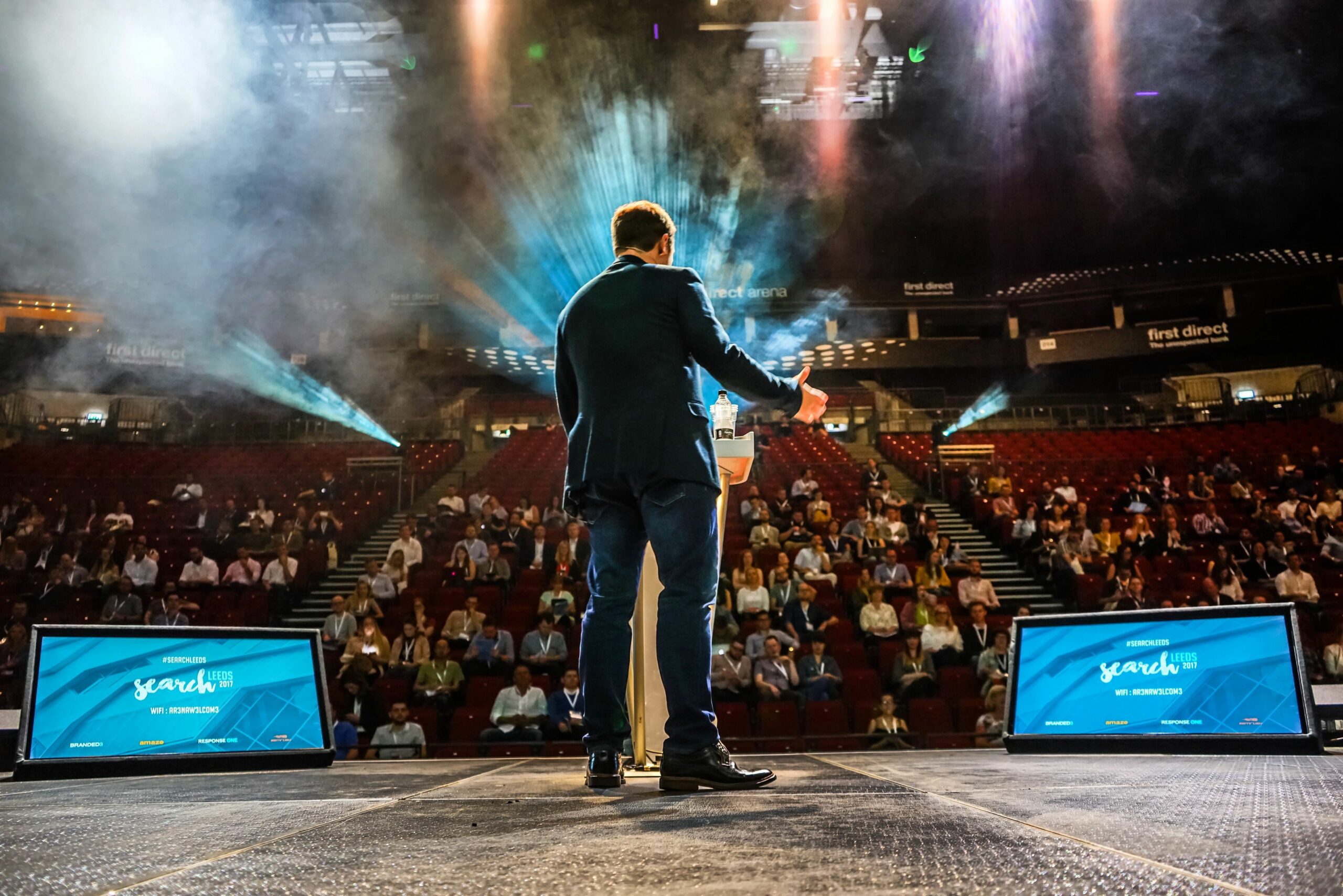
Stephen Kenwright – How to be Amazon and Beat Google at Search
Key Takeaways
1. Amazon or Search Engine?
- “People don’t think of Amazon as Search, but if you’re looking for something to buy, more often than not you are looking for it on Amazon” -Eric Schmidt
- We are now at a stage where we are ‘Googling’ it on Amazon
2. Where do Shoppers Start their Search?
- A) in 2015 21% started via a retailer B) 34% via Google and C) 45% via Amazon
- in 2016 16% started via a retailer B) 28% via Google and C) 56% via Amazon
- Remember to think about the user, and their journey!
3. SEO was about Building Links, now it’s about Building Search Engines
- Get better at informing customers than Google
- Control your own search
- Searchers generate more revenue than non-searchers
- Good news for all you SEOs: 84% of companies don’t optimise or even measure site search (so…there’s plenty of work to go round!)
Thank you to all of the incredible speakers, hosts, and of course Branded3 (shout out to Stephen Kenwright!) for bringing this event to life!
As this was a 3 track event and I was unable to attend each and every talk, you can check out all of the speakers slide-decks right here.
Though we didn’t take any #wingshots, we did take a few photo booth shots. Maybe some whisky shots too…

So @_JHoff is making us drink Fireball shots. #thiswontendwell pic.twitter.com/lHpr1teNUe
— Barry Adams (@badams) June 15, 2017

Here’s what attendees had to say about SearchLeeds:
The smoke machine and sea of millennials at #SearchLeeds make me feel like I’m at a Busted concert pic.twitter.com/anQKZ4V3Qt
— Nick Boyle (@Nick_Boyle) June 15, 2017
Brilliant job from the team @Branded_3 today. #searchleeds 2017 is set to be a good one! pic.twitter.com/wxb2GjKjDf
— Jon Greenhalgh (@jongreenhalgh) June 15, 2017
Absolutely superb last #searchleeds session with talks from @willcritchlow@aleyda and @stekenwright. Great end to an awesome event.
— Barry Adams (@badams) June 15, 2017
Brilliant close to #SearchLeeds thanks to @stekenwright from @Branded_3 who wants us all to meet him at the bar. Well, if we must…?
— DeepCrawl (@DeepCrawl) June 15, 2017
